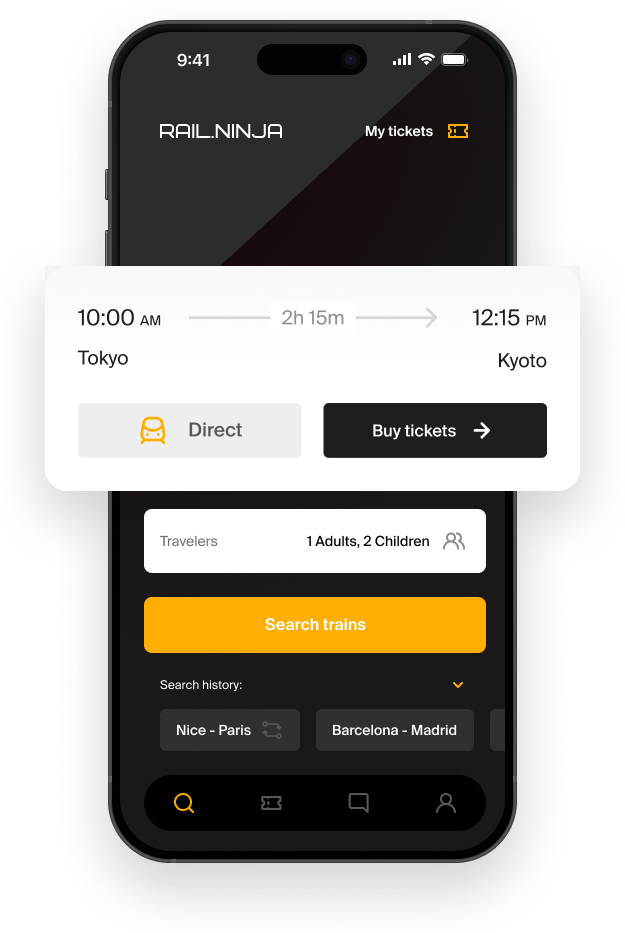JAPANESE TRAINS
Japanese High-Speed TrainsAnyone who was looking into Japan travel has heard about the world-famous Shinkansen. Although in English the word "Shinkansen" in most cases is used in the sense of "Japanese bullet train", the term also refers to the modern rail lines that are served by the renowned trains. The history of Japan's high-speed rail system, also known as the Shinkansen or Japanese bullet train, can be traced back to the debut of the Tokaido Shinkansen in 1964. Originally designed to foster economic growth by connecting remote regions to Tokyo, the system has since evolved to connect other major cities as well. Today, travelers can journey from Tokyo to Osaka, a popular tourist destination, in just two and a half hours. Despite facing opposition at its inception, the Shinkansen has become a shining example of advanced rail technology and has even inspired similar systems in other countries. The Japanese train system continues to be updated and improved to this day. |
Take a Look Inside Nozomi
Japanese bullet trains were a big success from the very beginning and became the nation's favorite within just a few years. Many European countries adopted Shinkansen technology after Japan's success! As a result, France introduced high-speed TGV trains in 1981, followed 10 years later by Germany's Intercity Express.Despite its 50-year age, don't think the Japanese high-speed rail network is outdated. Over decades, the system has been modified and improved. Updating technology wasn't the point. Instead, it was all about leading the way into the future. Tokaido Shinkansen, the first high-speed rail line in the world, has carried over 5.6 billion passengers since it opened. It operates 13 trains per hour during rush hour, each carrying over 20.000 passengers! Impressive, right?
And What Is Mini-Shinkansen?Japan was the first country to build special railway lines for high-speed travel, designed with a gauge of 1435 mm / 4 ft 8.5 in, compared to older lines' narrower gauge of 1067 mm / 3 ft 6 in. It worked wonders, but later another idea occurred. Expand the network by connecting some of the existing train tracks to Shinkansen trains, thus extending it even further? The concept of converted lines is called mini-shinkansen. But converting the lines was not the only problem. In addition to widening the track gauge, new Japanese trains with narrower cross-sections were introduced as old Shinkansen trains were not able to pass through tunnels along the old lines. This plan took about 5 years to implement, but the Yamagata Shinkansen line started operating in 1992. Shinkansen trains can run at 320 km/h (about 200 mph), but mini-shinkansen trains can only travel at 130 km/h (80 mph), increasing travel time compared to Shinkansen trains. |
Shinkansen Trains in JapanNow, when you know a bit about the history of the Japanese Shinkansen, let's have a close look at the trains that service the high-speed lines and share the name with the renowned railway. A bullet train, Japan's rail pride, is the fastest and the most comfortable mean of getting around the country. We can talk for hours about the amazing onboard amenities or tell you that the departure schedule of Shinkansen trains can impress even a very seasoned traveler. We can mention that their safety records are spotless, and there were exactly zero accidents involving passenger fatalities over the years. But you know that all already, as the name Shinkansen covers it all, being among the synonyms of first-class travel. |
| But did you know that there is more than one type of train, serving the Shinkansen railway? In fact, there are 6 of them and all boast different speed and make different stops along the way: 1. Nozomi trains are the most well-known of them. These Japanese trains are astonishingly fast (300 km/h or 83.3 mph), serve Tokaido, Sanyo, and Kyushu lines and make the least amount of stops. Seems unreal, but the Tokyo to Hiroshima travel time is less than 4 hours! 2. Hikari trains come second, they boast the same operating speed as Nozomi, but make more stops along the way. They operate on Tokaido and Sanyo railway lines. 3. Mizuho trains are another limited-stops high-speed trains, serving the Sanyo, and Kyushu lines. |
| 4. Kodama trains operate Tokaido and Sanyo lines together with Nozomin and Hikari listed above, but they make more stops along the way which increases travel times. 5. Hayabusa trains are the pride and joy of Hokkaido and Tohoku Shinhansen lines. This amazing Japanese bullet train boasts the top speed of up to 320 km/h (200 mph) and is crowned as the fastest train in Japan as well as the fastest category of trains, serving the lines listed above. 6. Sakura trains are last, but definitely not the least. This Shinkansen bullet trains operate on Sanyo & Kyushu Shinkansen lines. The trains from Osaka to Kagoshima run every hour throughout the day. |
Book Train Tickets in Japan
Shinkansen Train RoutesAt the moment, Shinkansen railway system consists of 7 high-speed lines, plus 2 more lines make up mini-shinkansen. Together, they spread throughout the whole country, cover all popular tourist destinations (as well as quite a few interesting off-the-beaten-path ones you should definitely check out), and make getting around Japan easier than it seems possible. Most travelers are interested in traveling from Tokyo to Kyoto, Tokyo to Nagoya, or Kyoto to Osaka, but do you know about other interesting cities to put on your Japan travel bucket list? Here, we have compiled all the essential information regarding the most popular Japanese train routes served by the Shinkansen, which includes the travel duration, frequency of daily departures, as well as the prices of Shinkansen tickets. |
Shinkansen Railway StationsAlthough Shinkansen trains make stops only at the most significant milestones along the way such as Tokyo Shinkansen Station, the bullet train network in Japan is so well-spread, that the final list of all train stations served by Shinkansen trains is still quite impressive. But regardless of where you are going and what is your departure point, you can rest assured that the train station is nothing but excellent. How can it be any other way when we are talking about Japan, the country with one of the most developed railway systems in the world? Our website provides valuable information regarding the Japanese train stations for the Shinkansen, such as their location, a short description emphasizing their benefits, and the available amenities that passengers can enjoy while waiting for their train's departure. |
Shinkansen TicketsThere's something exhilarating about traveling on a Japanese bullet train, or any high-speed train for that matter. The speed, the sleek design, and the efficiency make it a unique and exciting experience. However, navigating the train system and deciphering train tickets can be challenging, especially in countries with complex writing systems like Japan. It's important to plan ahead, do your research, and ask for help when needed to ensure a smooth and enjoyable journey on a Japanese train. But there is no need to worry, as Shinkansen are among the most popular connections among tourists, so conveniently all the main information is offered in Japanese and English. To make preparing for your trip as easy as possible, we've prepared instructions on how to read train tickets in Japan as well as suggestions on the best way to book them. |
What to Know About Shinkansen Trains
- Are Shinkansen trains the fastest in the world?At the moment no, they aren't, this title goes to Shanghai Maglev train. But, it's worth mentioning that the ALFA-X version of the Shinkansen train is currently undergoing test runs. This train can supposedly run at 360 km/h (224 mph), so it will definitely steal the crown from Maglev when it enters operation around 2030.
- Why are Shinkansen trains so fast?The secret is in the amazing design and its careful embodiment. For example, the train cars are very light and their form is as aerodynamic as possible, the train tracks have no sharp curves, and the coaches are air-sealed to ensure stable air pressure. Unfortunately, we can't tell you all the secrets, they are carefully guarded by Hitachi.
- Where do bullet trains go in Japan?The Shinkansen network is very extensive, and covers the following lines: Tokyo - Osaka, Osaka - Hakata, Tokyo - Aomori, Hakata – Kagoshima, Tokyo – Niigata, Takasaki – Kanazawa, Aomori - Hokuto. Mini-shinkansen also covers Morioka – Akita and Fukushima – Shinjo lines.
- Is Shinkansen railway scenic?The train network spreads all over the country, and Japanese is definitely not short of wonderful views. Traveling by Japanese high-speed trains is a brilliant way to admire the breathtaking landscapes and fall in love with this incredible place a bit more with every trip.









